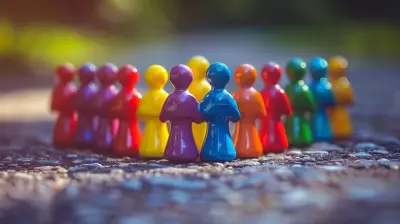How to Create Safe Spaces for Emotional Expression in Relationships
7 June 2025
Alright, let’s get real for a hot second—if your idea of emotional expression in relationships is texting “I’m fine” with a passive-aggressive emoji, we need to talk. Deep down, everyone craves the kind of relationship where you can rip off the emotional mask and say what’s really going on inside without getting judged, dismissed, or bulldozed.
Creating a safe space for emotional expression isn’t just a cute idea from a self-help book. It’s the glue that keeps relationships thriving, especially when life throws its inevitable curveballs. Whether you’re in a romantic partnership, a friendship, or any relationship that matters, let's dive into the real-deal strategies for building that emotionally secure vibe where both parties can speak their truth without fear.

What Exactly Is a “Safe Space” in Relationships?
Let’s clear the air. We’re not talking about fluffy pillows and aromatherapy candles here (although hey, those don’t hurt). A “safe space” in emotional terms is a judgment-free, open, and supportive environment where both people feel comfortable being vulnerable.Think of it as an emotional bubble wrap—where your thoughts and feelings are handled gently, not stomped on by criticism, sarcasm, or plain ol’ indifference. It’s about feeling heard, seen, and accepted, even when you’re at your messiest.

Why Emotional Safety Is the Underrated MVP
Before we start building this warm and fuzzy fortress of emotional security, let’s hit the “why.” Why should you care?Because if emotional safety is missing, say goodbye to trust, communication, and intimacy. You’ll feel like you're walking on emotional eggshells, constantly censoring yourself to avoid conflict. Ain’t nobody got time for that!
But when it’s there, magic happens:
- You argue with love, not toxicity.
- You grow together instead of drifting apart.
- You build a relationship where honesty doesn’t feel like playing Russian roulette.
Now that your “why” is on lock, let’s get into the “how.”
1. Start With Self-Awareness—Check Your Emotional Baggage at the Door
You can’t create a safe space for someone else if your own emotional closet is overflowing with unresolved junk. We all carry emotional baggage, but dragging it into every conversation will only trip you both up.Ask yourself:
- Am I reacting to them, or to something from my past?
- Do I know how to regulate my own emotions without offloading them like a toddler with a tantrum?
Before opening your mouth, check your emotional temperature. And yes, it’s okay to say, “I need a minute” if you’re about to pop off. That’s emotional maturity, baby.
2. Active Listening Is Not Just Nodding Like a Bobblehead
Spoiler alert: Listening is not waiting for your turn to speak. It means fully tuning in with curiosity, not judgment.Here’s how to level up your listening game:
- Put away distractions. Yes, that includes your phone!
- Don’t interrupt, finish their sentences, or one-up their experiences.
- Validate their feelings even if you don’t totally get them. A simple “That sounds really tough” goes a long way.
- Ask clarifying questions like, “What do you need from me right now—support or solutions?”
The goal here is to listen to understand, not to win. Trust me, no one likes being emotionally mansplained.
3. Drop the Defensiveness—You’re Not on Trial
You’re not always gonna like what your partner has to say. But getting defensive every time someone shares how they feel? That’s emotional sabotage.If you reply to “I felt hurt when you…” with “Well, YOU always…” congratulations—you've just shut the safe space down.
Instead, try this:
- Take a breath before reacting.
- Assume good intentions.
- Respond with, “I hear you. That wasn’t my intention, but I understand how it came off that way.”
Remember, accountability isn’t an admission of being a terrible human. It’s the grown-up version of saying, “I care about your feelings more than I care about being right.”
4. Set Boundaries Without Building Walls
Safe spaces don’t mean anything goes 24/7. Boundaries are not just okay—they’re essential. But there’s a difference between healthy boundaries and emotional barricades.Examples of healthy boundaries:
- “I want to talk, but I need a little time to cool down first.”
- “I'm here for you, but can we discuss this when I’m not at work?”
- "I'm open to hearing your feelings, but let’s keep it respectful."
Boundaries help you show up as your best self. No one can pour from an empty cup, honey.
5. Validate, Validate, Validate (Even If You Don’t Agree)
Validation is the velvet rope of emotional connection. It says, “Your feelings are welcome here.”And no, validation doesn’t mean agreeing with everything the other person says. It means acknowledging their feelings as real and important.
Imagine someone saying, “I feel ignored when you’re on your phone during dinner,” and you reply with, “That’s ridiculous—I was just checking an email.” Boom. Space = no longer safe.
Instead say: “I didn’t realize it came off that way. I can see how that would feel hurtful.”
Be the person who makes others feel like it’s okay to feel. It’s a freaking superpower.
6. Show Up Consistently—Not Just When It’s Convenient
Emotional safety isn’t built in one deep convo or grand gesture. It’s in the day-to-day consistency—the check-ins, the encouragement, the respect even when you’re angry.Ask yourself:
- Do I make time for meaningful connection?
- Am I emotionally present, not just physically around?
- Do I follow through on my promises, even the small ones?
Trust is built in the micro-moments. So be someone your partner or friend can count on, like emotional WiFi—always connected, never glitchy.
7. Speak Your Truth With Compassion
Being honest doesn’t mean being brutal. If your “truth” comes wrapped in sarcasm, criticism, or yelling, it’s not truth—it’s emotional dumping.Here's how to express yourself without turning it into a drama series:
- Use “I” statements: “I feel hurt when you cancel plans” instead of “You never show up.”
- Stick to specific examples, not vague generalizations.
- Don’t weaponize past mistakes. Stay in the now.
Speak from the heart, not from your ego. That’s how real connection grows.
8. Apologize Like You Mean It
If you mess up—and you will, ‘cause welcome to being human—don’t just drop a half-hearted “sorry” and expect things to go back to normal.A real apology includes:
- Acknowledging the hurt.
- Taking responsibility (no “but YOU…” allowed).
- Describing what you’ll do differently next time.
Trust is fragile, and a sincere apology can be the emotional glue that puts it back together.
9. Celebrate Vulnerability Like It’s a Win (Because It Is)
Expressing feelings can be terrifying. It’s like emotionally streaking—laying it all bare and hoping you won’t get laughed at.So when someone opens up to you, treat it like a freaking honor. Thank them for their trust. Celebrate the courage it took.
And when it’s your turn to get vulnerable? Take the risk. Real love, whether romantic or platonic, grows in the soil of honesty.
10. Make It Mutual—Safe Spaces Go Both Ways
This isn’t a one-way street. You can’t expect someone to pour their soul out if you’re sitting there like an emotional brick wall.Let them in, too:
- Share your fears, your dreams, your weird anxious thoughts.
- Be open about your triggers and what you need to feel secure.
- Let them support you instead of always being the rock.
Mutual vulnerability deepens the connection. It’s like doing the emotional cha-cha—you both gotta move in sync.
Final Thoughts: Keep the Door Open
Creating safe emotional spaces in relationships isn’t a one-and-done thing. It’s ongoing. It takes intention, patience, and more than a few awkward conversations. But the payoff? Relationships that aren’t just surviving, but thriving.You deserve emotional intimacy that feels like coming home, not like walking through a minefield. So make that space. Keep it sacred. And never stop showing the people you love that they can show up as all of who they are—messy, magical, emotional selves included.
Because at the end of the day, love without a safe space is just a street with a dead end. Let your love breathe.
all images in this post were generated using AI tools
Category:
Emotional ExpressionAuthor:

Paulina Sanders
Discussion
rate this article
3 comments
Valen Heath
Thank you for this insightful article! Creating safe spaces for emotional expression is vital for nurturing healthy relationships. Your tips are practical and encourage deeper connections. Much appreciated!
June 20, 2025 at 3:00 AM

Paulina Sanders
Thank you for your kind words! I'm glad you found the tips helpful for fostering deeper connections. Your feedback is much appreciated!
Vanya McGinn
This article beautifully highlights the importance of safe spaces for emotional expression in relationships. Creating an environment where both partners feel heard and valued is essential for deepening connection and trust. Thank you for sharing these insightful strategies—implementing them can truly transform our interactions and strengthen our bonds!
June 12, 2025 at 4:56 AM

Paulina Sanders
Thank you for your thoughtful comment! I'm glad you found the strategies helpful for fostering deeper connections in relationships. Your insights on the importance of safe spaces are spot on!
Hugo Forbes
Creating safe spaces for emotional expression in relationships is essential for fostering trust and vulnerability. By actively listening and validating feelings, partners can enhance emotional intimacy, leading to deeper connections and healthier conflict resolution, ultimately strengthening the relationship's foundation.
June 7, 2025 at 3:16 AM

Paulina Sanders
Thank you for highlighting the importance of safe spaces! Your insight on active listening and validation truly reinforces how crucial these practices are for building trust and enhancing emotional intimacy in relationships.



